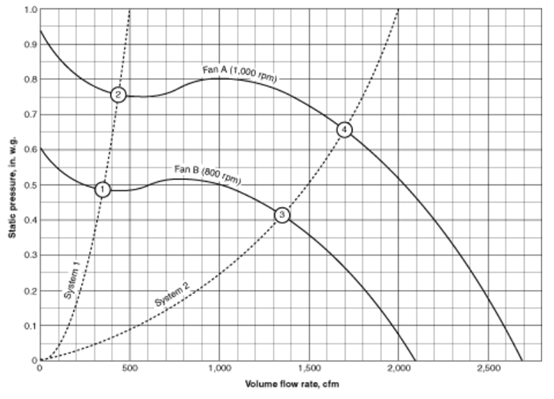A centrifugal impeller with forward-curved blades produces more cfm and more static pressure at a given rpm than either radial or backward-curved impellers. Consequently, forward-curved centrifugal fans are popular in domestic equipment, where space is often at a premium and noise must be kept to a minimum.
Forward-curved centrifugal fans display a typical “dip” in their performance curves. Remember from Figure 1 that the area to the left of the peak is the so-called “unstable” portion of the curve, where operation is to be avoided. If you are considering a particular fan for a given system, and the point of operation falls in this unstable area, you may be able to solve the problem by selecting a narrower model with the same impeller diameter (and nearly the same rpm). This is to say that the efficient operating range of a narrower centrifugal fan falls to the left of a wider one’s.

Figure 1. Two fan curves and two system curves result in four points of operation
Look back at Figure 2, which plots cfm against horsepower for two forward-curved centrifugal fans. As you can see, for a given fan speed, the required horsepower goes up as the system resistance goes down (and cfm delivery increases). This can be demonstrated by removing an air conditioning unit from the air distribution system and running it in free air. Often the motor will overheat to the point of cutting out on overload.

Figure 2. Fan performance curves that plot cfm against brake horsepower
The performance curve of a backward-curved centrifugal fan usually does not display a “dip” to the left of the peak cfm/static pressure point. As a result, a backward-curved centrifugal fan may not have an unstable range. Figure 3 shows cfm plotted against both static pressure and horsepower for a typical backward-curved centrifugal fan.

Figure 3. Typical performance curves for centrifugal fans with backward-curved blades
A backward-curved centrifugal fan may be designed to be non-overloading. That is, for a given rpm, the required horsepower reaches a maximum at some point to the left of free delivery. Further decreases in system resistance do not require an increase in horsepower.
This can be quite advantageous in large commercial installations, where the added capacity needed to ensure freedom from mechanical breakdown can represent a large investment in an oversized motor. The necessarily higher speed, larger size, and extra cost of backward-curved centrifugal fans is offset by the higher fan efficiencies achieved over a wider range of system resistance. Greater efficiency, in turn, can mean smaller motors and therefore lower operating costs.
Figure 4 shows performance curves for a typical propeller fan. The shaded areas show maximum operating efficiency ranges for propeller fans and comparably sized centrifugal fans. As you can see, the normal operating range of the propeller fan (the area in which the point of operation should be located) falls to the right of that of the centrifugal fan. This means that propeller fans perform better when system resistance is low–which is one of the reasons why this type of fan is found in air-cooled condensers and cooling towers. In such systems, ductwork normally is not used, and large volumes of air are required in proportion to the static pressure created.
Attempts to make a propeller fan do a job that requires a centrifugal fan, at best, be only partially successful. The additional rpm required often creates objectionable noise, excessive power consumption, and structural failure.

Figure 4. Typical propeller performance curves

Figure 5. Typical mixed-flow fan performance curves (shaded area shows maximum operating efficiency)
Related Posts:
Overview of Centrifugal Fan Types
A typical supply fan or impeller (wheel) can be described by the blade constructions. The distinguishing characteristic is the shape of the individual fan blades and their orientation relative to wheel rotation…
Centrifugal Fan Performance Curves
As you have known, you must know what the capacity of a fan is before you consider opening a damper or increasing the fan speed. Doing so may not be safe—it could result in an overloaded motor…
